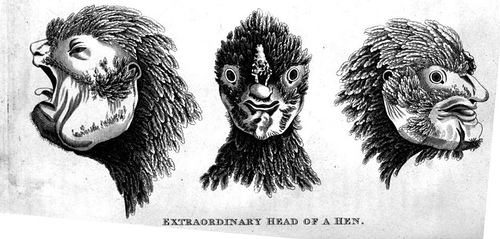When the Swedish cargo steamer Baychimo became trapped in pack ice in 1931, the crew abandoned her and assumed that she sank in a subsequent blizzard. So they were surprised to hear that a local seal hunter had spotted her 45 miles away. They found the ship and retrieved the most valuable cargo, but still she did not sink. In fact, the Baychimo would be sighted numerous times throughout the next 38 years, most recently in the Beaufort Sea in 1969. For all anyone knows, she’s still up there.
Oddities
“A Most Unnatural Bargain”

If you’re selling a house in New York, you must disclose the presence of poltergeists. That’s the finding of the New York Supreme Court in Stambovsky v. Ackley, widely known as the “Ghostbusters case of 1991.”
When Jeffrey Stambovsky offered to buy Helen Ackley’s house in Nyack, he didn’t know it was haunted. Stambovsky tried to back out of the deal, but a trial court dismissed his suit.
When he appealed the case, the new court noted that, since the seller had reported the ghosts in Reader’s Digest, she couldn’t claim that they didn’t exist. “As a matter of law, the house is haunted.”
And, it said, a buyer couldn’t be expected to discover ghosts on his own, because “the most meticulous inspection and search would not reveal the presence of poltergeists at the premises or unearth the property’s ghoulish reputation in the community.”
So Stambovsky got no damages but escaped the contract. Moral: caveat emptor.
King Crab

All right, keep your seats. Bathynomus giganteus is an example of “deep-sea gigantism,” where creatures assume huge sizes in the cold black mud a mile down, perhaps to better regulate body temperature.
It’s related to the woodlouse, if that’s any comfort.
“Hen With a Human Face”

A “hen with a human profile” found near the Russian city of Tula in 1816, reported in Kirby’s Wonderful and Scientific Museum (1820).
“As the beak is wanting, and has for substitute a kind of mouth, it is very difficult for her to eat, and still more so to collect grains,” reports a Professor Fischer. “The too great advancement of the nostrils prevents her altogether from drinking; it is, therefore, necessary to feed her with bread soaked in water, or in milk.”
Wait a Minute …
Every May and December, thousands of Catholics gather in Naples to witness a miracle: The dried blood of Saint Januarius, which is kept in small capsules, liquefies when it’s brought near his body.
Januarius was martyred in 305, and the “miracle of the blood” has been happening since at least 1389, which is pretty impressive.
But investigator Joe Nickell notes that a thixotropic gel such as hydrated iron oxide remains highly viscous until it’s stirred or moved. And the same miracle is claimed for several other saints … all in the Naples area. Hmm.
2BR, Bath, Tail

Dinny the Dinosaur isn’t just an eyesore, he’s a habitable building. Created in the 1960s to attract visitors to a nearby inn, the 150-ton brontosaurus has an entrance at the base of his tail, and his builder, Claude Bell, used to live in the upper rooms. You can see Dinny in Cabazon, Calif., just north of Interstate 10.
Ironically, he’s now been turned into a creationist museum. Perhaps you’d prefer to stay in an elephant?
Fish Story II
On Oct. 26, 1873, fishermen Daniel Squires and Theophilus Piccot set out to fish for herring off Portugal Cove, Newfoundland. With them in the 20-foot dory was Piccot’s 12-year-old son, Tom.
On the water they spied a mass of flotsam that they took for wreckage or seaweed, but when they tried to draw it near with a boathook the thing struck the gunwale with a parrotlike beak and threw a tentacle around the boat. Thinking quickly, the boy hacked at the attacking creature until it released the dory and retreated.
The trio returned to port with a severed tentacle 19 feet long, which they gave to the Rev. Moses Harvey, an amateur naturalist in St. John’s. It’s thought to be the first conclusive proof of the existence of giant squid.
Fun With Breeding

With enough patience, you can breed an animal to do almost anything. When medieval Norwegians wanted help hunting puffins, which nest in cliffs and burrows, they created the Norwegian lundehund, which is practically a puffin-hunting machine. A lundehund can close its ears, turn its forelegs at right angles to its sides, and bend its head backward until its forehead touches its back. Plus it has an extra toe.
When the puffin hunters switched to nets, the breed nearly disappeared — by World War II there were only six left. But now they’re back up to around 2,000. Waste not, want not.
Location, Location, Location
Petersburgh, July 30, 1817. — The ground of a village, distant twenty-two versts from Abo, has sunk suddenly to the depth of many fathoms, and twelve peasants’ houses have been buried in a manner that no trace remains of their former position. A similar event happened at the same place, in the years 1755 and 1788. Among other unknown causes of this phenomenon, it is attributed to the situation of the village upon a swampy soil, and to a river which flows beside it. It is not stated, whether any lives were lost.
— London Morning Post, Aug. 30, 1817
Grrrr

Sweden’s Björketorp runestone (center, above) certainly means business. Thirteen feet tall, it bears this threatening inscription:
Here, I have hidden the secret of powerful runes, strong runes. The one who breaks this memorial will be eternally tormented by anger. Treacherous death will hit him. I foresee perdition.
That’s scary, but it’s not very clear. Archaeologists had thought the curse protected a grave, but a dig in 1914 found no remains. So maybe it’s a cenotaph (meaning the body is buried elsewhere), or a shrine to Odin, or an ancient border marker between Sweden and Denmark. Anyway, be vaguely careful.
